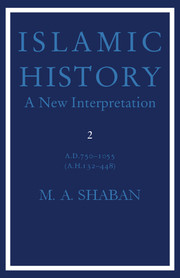Book contents
- Frontmatter
- Contents
- Acknowledgements
- Preface
- 1 The founding of the ʿAbbāsid regime
- 2 Towards a civil war
- 3 Dissolution under a new regime
- 4 The origins of the iqṭāʿ
- 5 Regional economic conflicts
- 6 The breakdown of the central government (I)
- 7 The breakdown of the central government (II)
- 8 The Būyid confederacy
- 9 The Fātimids
- Works cited
- Index
- Frontmatter
- Contents
- Acknowledgements
- Preface
- 1 The founding of the ʿAbbāsid regime
- 2 Towards a civil war
- 3 Dissolution under a new regime
- 4 The origins of the iqṭāʿ
- 5 Regional economic conflicts
- 6 The breakdown of the central government (I)
- 7 The breakdown of the central government (II)
- 8 The Būyid confederacy
- 9 The Fātimids
- Works cited
- Index
Summary
The collapse of the central government and the emergence of the Daylamites mark the beginning of the division of the Islamic lands into two distinct spheres, the line of demarcation running along the western slopes of the Zagros mountains down the east coast of the Persian Gulf. To the east of this line the Iranian world, though by no means united, consistently regained its identity. To the west, the Arab world, also disunited, continued to survive almost on the same lines as we know it today. The Arab conquerors had succeeded in pushing the Buddhist wall as far back as the Chinese borders and thereafter the regions of Outer Iran had become an integral part of the Islamic domain. Yet these regions of what the Arabs had called the East, because of the circumstances of the conquest, had continued to have a rather special status within the empire. On the other hand, western Iran, the seat of the Sāsānians, had been more affected by Arab penetration and subsequent control. From the point of view of the Arabs the areas extending eastwards into the Iranian central plateau had been considered their property. In the first two centuries of Islam, Ṭabasayn, to the north-east of the Dasht-i-Kavīr desert, had been the border point and the “door” to the East. Under the Ṭāhirids, this point had been pushed westward to Rayy, and now it was the turn of the Daylamites to push it further west into ʿIrāq.
- Type
- Chapter
- Information
- Islamic HistoryA New Interpretation, pp. 159 - 187Publisher: Cambridge University PressPrint publication year: 1976



